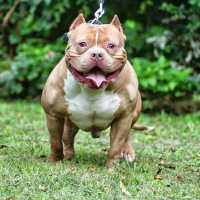Appearance of the American Bully
|
| American Bullies aren't hard to spot, as they generally resemble the man who spends too much time at the gym. Three of the four recognized types share a very similar appearance, generally varying only in overall weight and height but retaining almost all the same general characteristics. They are easily one of the most muscular breeds and have been bred to have broad chests. They have large, square but not oversized heads, with well-defined, square, short, broad cheeks, well-defined muzzles and broad noses, of unrestricted color. Their eyes are oval-shaped and generally all colors except blue, while their ears are set high and may be natural or cropped. They have medium-length but very muscular necks, broad, deep chests, well-defined shoulder blades and wide front stance. The hindquarters are easily, if not more, muscularly developed than those at the front, and are topped by a slight curve at the back. Their tails are thick and tapered, and come in straight or curved styles. Their coats are shiny and smooth but have a bit of coarseness and come in all colors and patterns except true albino and robin. |
Temperament of the American Bully
|
| Among all the accounts of American Bullies today, the most common traits among all sizes and types are that they are very affectionate with their families and have a zest for life that they exhibit regularly. They are also known to be a highly intelligent breed, but because of this, the learning curve and patience required to train them thoroughly means that they will most often need an experienced and consistent owner to get the best out of their behavior. Although they are generally good at home with family and children, they can be a little aloof with strangers and other dogs. It is therefore strongly recommended that they are well trained and socialized from an early age. Those unable to keep a firm hand and consistent direction would do better to adopt an adult dog that has already undergone the rigors of training. They are also outgoing and courageous, which is another reason why they make great dogs when fully socialized, as they will do almost anything asked of them to please their owners. Despite what may seem like an obstacle in terms of general build, they are in fact surprisingly athletic and will participate in recreation with vigor, but be warned, they are extremely strong and often show their affection with challenging games. If nothing else, their growing popularity is a strong testament to their status as beloved companions, even if they require a great deal of patience, training and socialization, as the end results are highly desirable. |
Needs and activities of the American Bully
|
| Partly because of their musculature and partly because of their size, American Bullies generally need a fair amount of exercise on a regular basis to stay happy and healthy. It's difficult to put a direct figure on how long or how much they'll actually need, as the range of types and sizes is quite vast, but in general, the smaller the dog, the less exercise they'll need, as their legs will be shorter to work harder than their longer-legged relatives. To be on the safe side, give them around 60 minutes of daily exercise and around 16 km of walking/running per week. Measure their ability to keep up with high-intensity activities, as their shorter muzzles can compromise breathing efficiency and make them dizzy if they exert themselves too much. |
Maintenance of the American Bully
|
| American Bullies are considered a low-maintenance breed. They wear a short coat on average, but it's best to brush them several times a week with a stiff bristle brush to keep their coat healthy and your home less hairy. In general, they keep fairly clean and don't need to be bathed regularly, unless they're caught unawares. Their nails need to be checked and trimmed regularly to avoid cracks or painful cuts. Their teeth should be brushed once a week, if possible more often than would be ideal, and could avoid costly dental expenses in the future. |







 English (United Kingdom)
English (United Kingdom)